cooling TOYOTA AVALON 2012 XX40 / 4.G Owners Manual
[x] Cancel search | Manufacturer: TOYOTA, Model Year: 2012, Model line: AVALON, Model: TOYOTA AVALON 2012 XX40 / 4.GPages: 580, PDF Size: 9.33 MB
Page 402 of 580
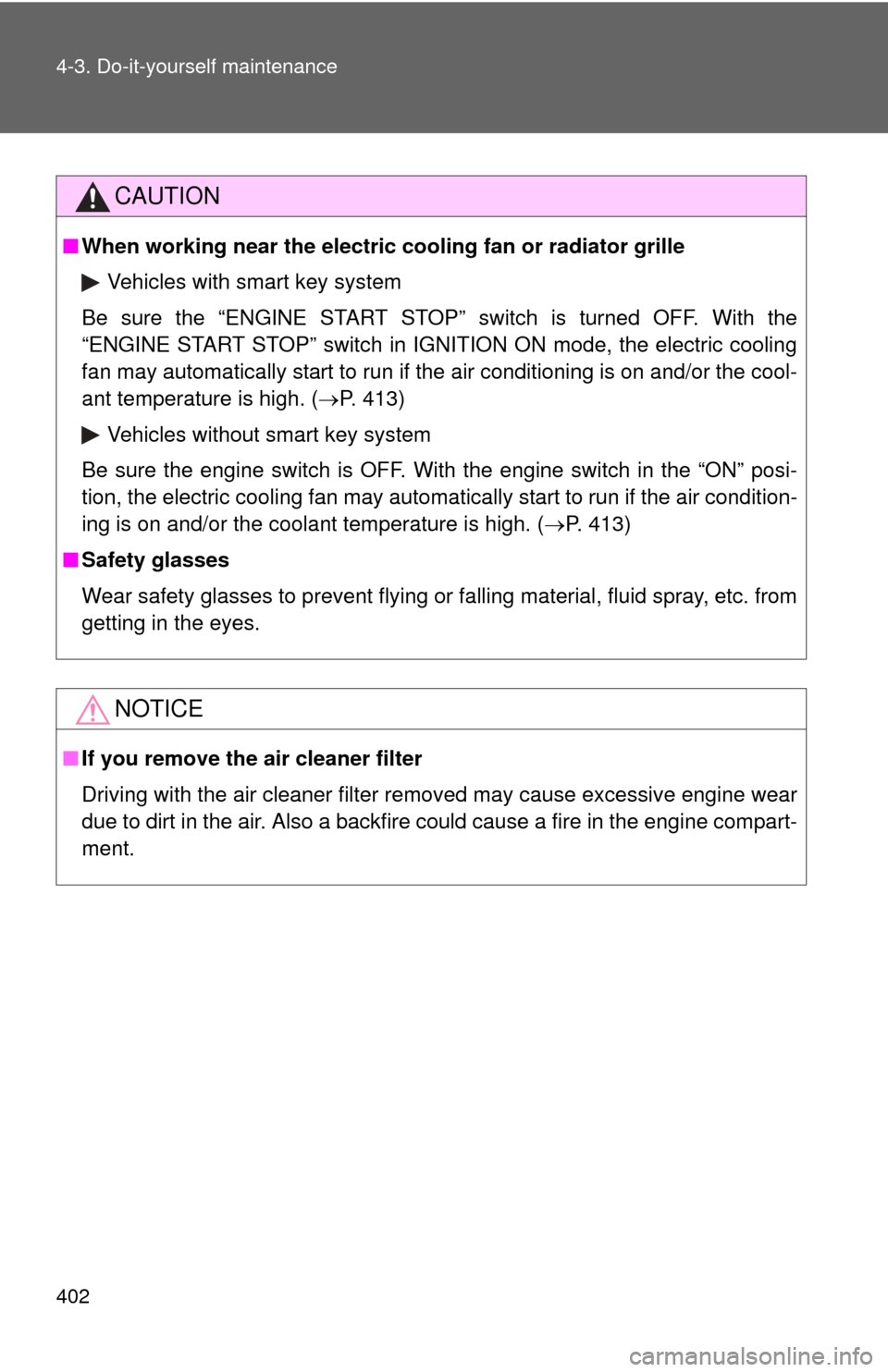
402 4-3. Do-it-yourself maintenance
CAUTION
■When working near the electric cooling fan or radiator grille
Vehicles with smart key system
Be sure the “ENGINE START STOP” switch is turned OFF. With the
“ENGINE START STOP” switch in IGNITION ON mode, the electric cooling
fan may automatically start to run if the air conditioning is on and/or the cool-
ant temperature is high. ( P. 413)
Vehicles without smart key system
Be sure the engine switch is OFF. With the engine switch in the “ON” posi-
tion, the electric cooling fan may automatically start to run if the air condition-
ing is on and/or the coolant temperature is high. ( P. 413)
■ Safety glasses
Wear safety glasses to prevent flying or falling material, fluid spray, etc. from
getting in the eyes.
NOTICE
■If you remove the air cleaner filter
Driving with the air cleaner filter removed may cause excessive engine wear
due to dirt in the air. Also a backfire could cause a fire in the engine compart-
ment.
Page 406 of 580
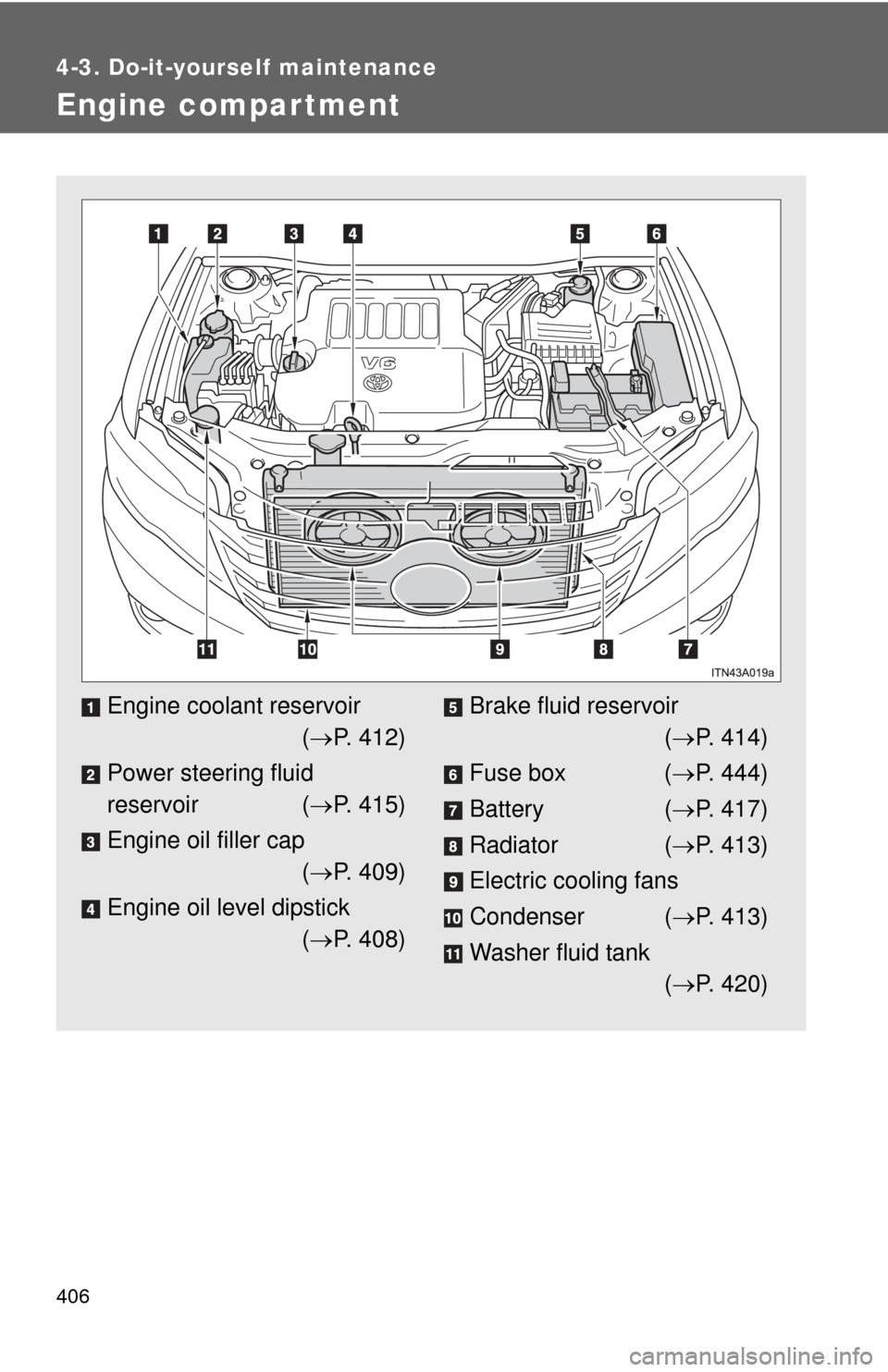
406
4-3. Do-it-yourself maintenance
Engine compar tment
Engine coolant reservoir( P. 412)
Power steering fluid
reservoir ( P. 415)
Engine oil filler cap ( P. 409)
Engine oil level dipstick ( P. 408)Brake fluid reservoir
( P. 414)
Fuse box ( P. 444)
Battery ( P. 417)
Radiator ( P. 413)
Electric cooling fans
Condenser ( P. 413)
Washer fluid tank ( P. 420)
Page 412 of 580
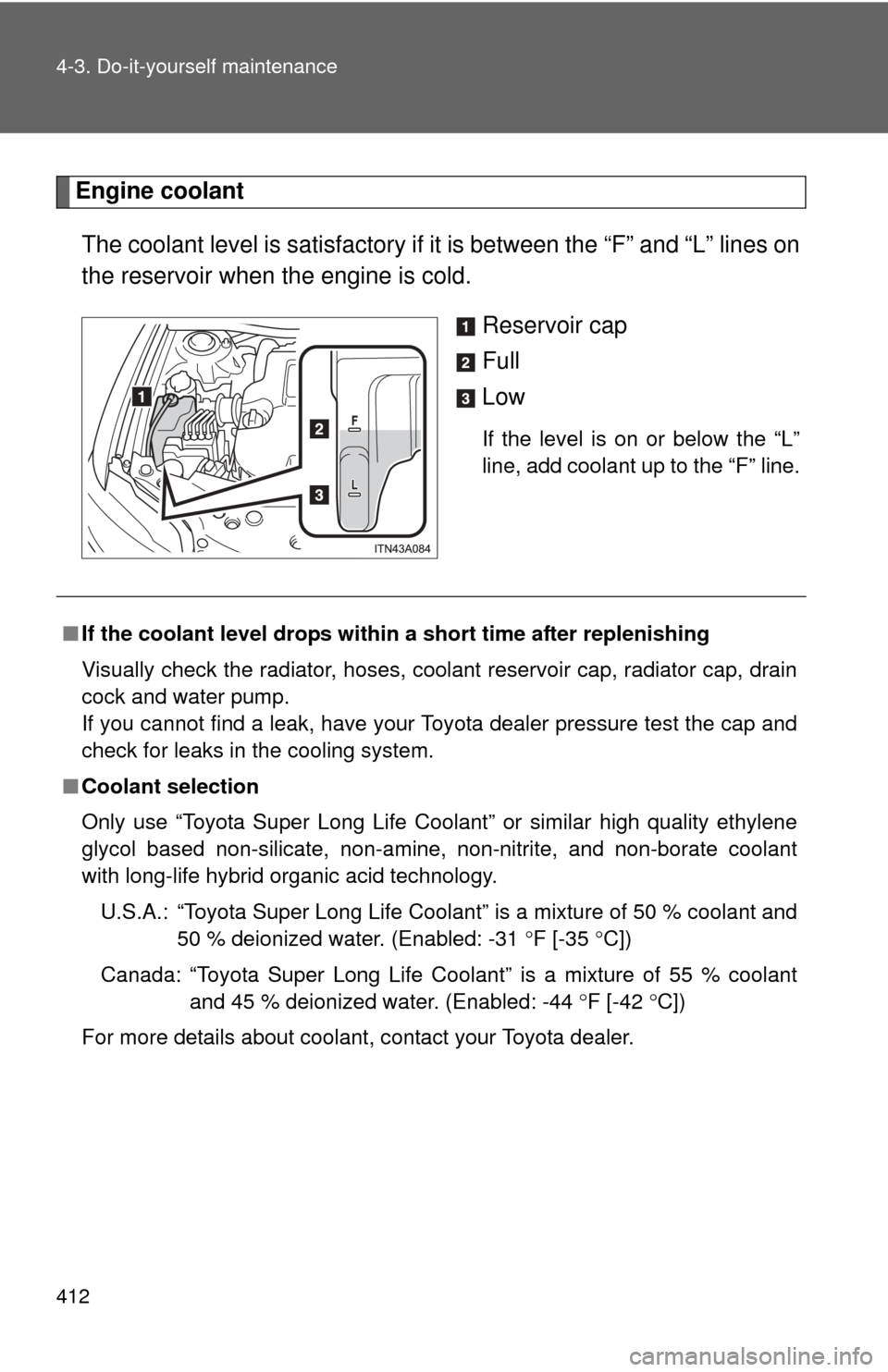
412 4-3. Do-it-yourself maintenance
Engine coolantThe coolant level is sati sfactory if it is between the “F” and “L” lines on
the reservoir when the engine is cold.
Reservoir cap
Full
Low
If the level is on or below the “L”
line, add coolant up to the “F” line.
■If the coolant level drops within a short time after replenishing
Visually check the radiator, hoses, coolant reservoir cap, radiator cap, drain
cock and water pump.
If you cannot find a leak, have your Toyota dealer pressure test the cap and
check for leaks in the cooling system.
■ Coolant selection
Only use “Toyota Super Long Life Coolant” or similar high quality ethylene
glycol based non-silicate, non-amine, non-nitrite, and non-borate coolant
with long-life hybrid organic acid technology.
U.S.A.: “Toyota Super Long Life Coolant” is a mixture of 50 % coolant and 50 % deionized water. (Enabled: -31 F [-35 C])
Canada: “Toyota Super Long Life Coolant” is a mixture of 55 % coolant and 45 % deionized water. (Enabled: -44 F [-42 C])
For more details about coolant, contact your Toyota dealer.
Page 413 of 580

4
Maintenance and care
413
4-3. Do-it-yourself maintenance
Radiator and condenser
Check the radiator and condenser and clear any foreign objects.
If either of the above parts are extremely dirty or you are not sure of
their condition, have your vehicl e checked by your Toyota dealer.
CAUTION
■When the engine is hot
Do not remove the radiator cap.
The cooling system may be under pressure and may spray hot coolant if the
cap is removed, causing serious injuries, such as burns.
NOTICE
■When adding the coolant
Coolant is neither plain water nor stra ight antifreeze. The correct mixture of
water and anti freeze must be used to provide proper lubrication, corrosion
protection and cooling. Be sure to read the antifreeze or coolant label.
■ If you spill coolant
Be sure to wash it off with water to prevent it from damaging to parts or paint.
CAUTION
■When the engine is hot
Do not touch the radiator or condenser as they may be hot and cause seri-
ous injuries, such as burns.
Page 446 of 580
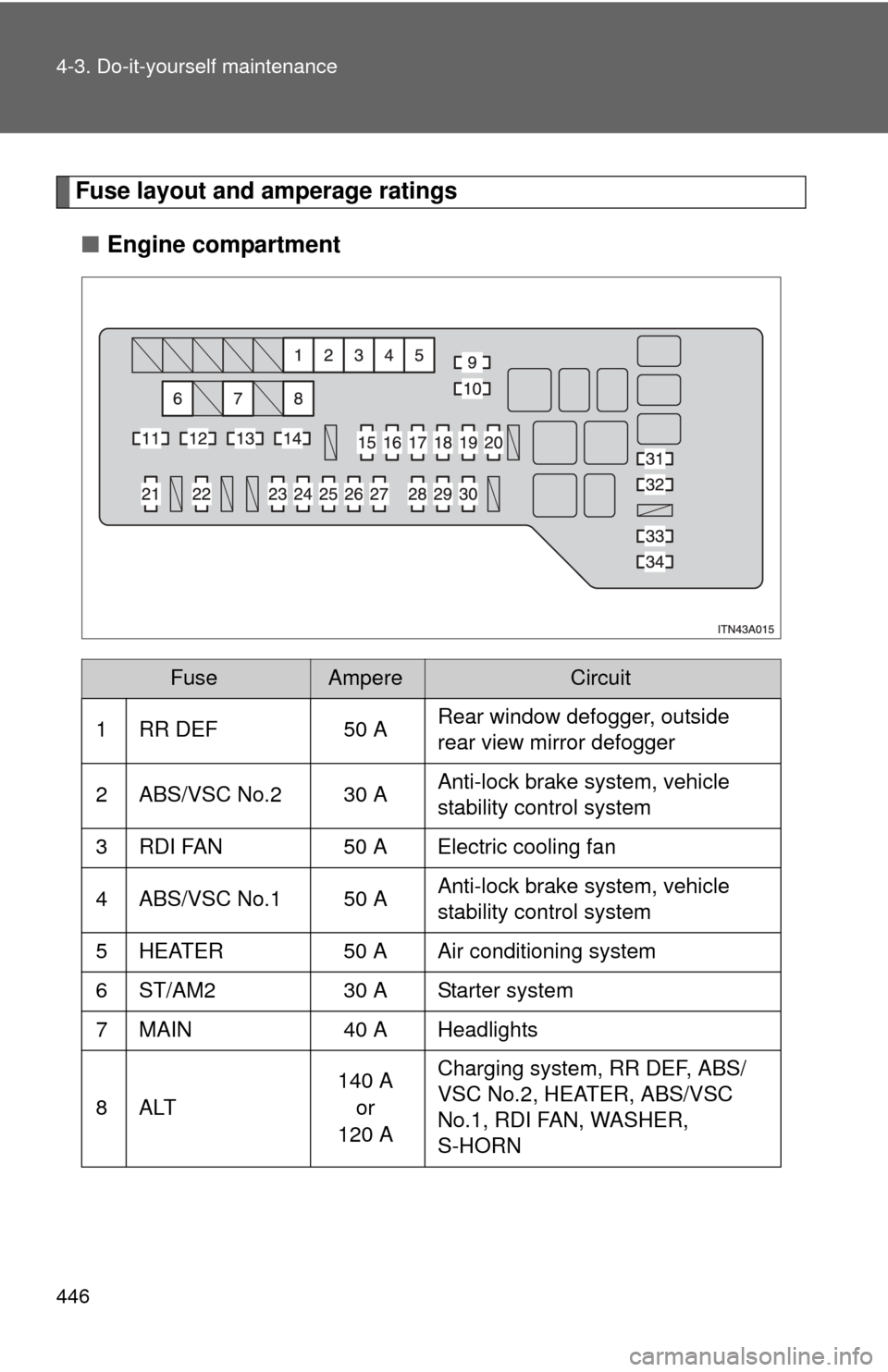
446 4-3. Do-it-yourself maintenance
Fuse layout and amperage ratings■ Engine compartment
FuseAmpereCircuit
1 RR DEF 50 A Rear window defogger, outside
rear view mirror defogger
2 ABS/VSC No.2 30 A Anti-lock brake system, vehicle
stability control system
3 RDI FAN 50 A Electric cooling fan
4 ABS/VSC No.1 50 A Anti-lock brake system, vehicle
stability control system
5 HEATER 50 A Air conditioning system
6 ST/AM2 30 A Starter system
7 MAIN 40 A Headlights
8ALT 140 A
or
120 A Charging system, RR DEF, ABS/
VSC No.2, HEATER, ABS/VSC
No.1, RDI FAN, WASHER,
S-HORN
Page 450 of 580
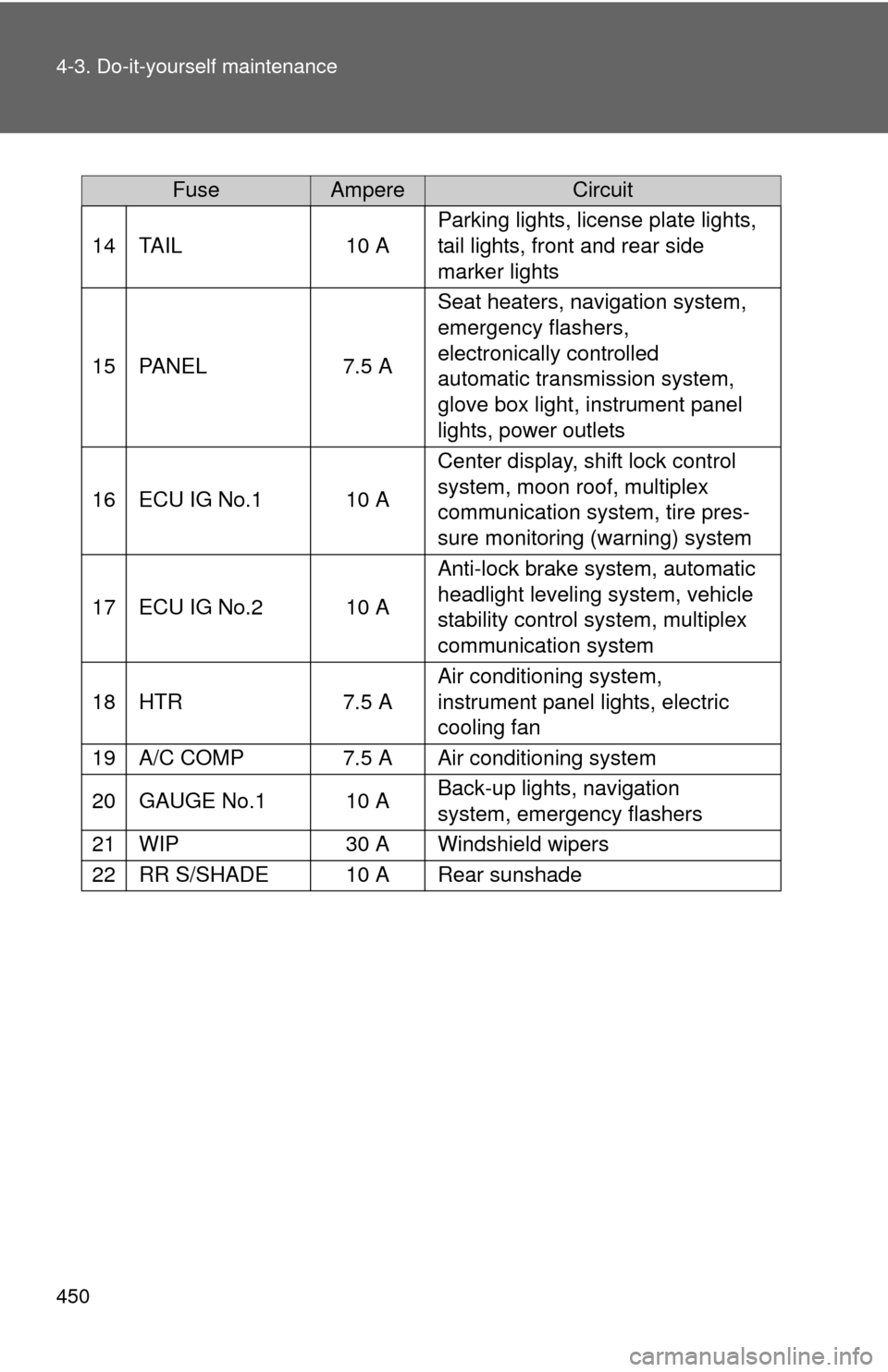
450 4-3. Do-it-yourself maintenance
FuseAmpereCircuit
14TA I L10 A
Parking lights, license plate lights,
tail lights, front and rear side
marker lights
15PA N E L7.5 A
Seat heaters, navigation system,
emergency flashers,
electronically controlled
automatic transmission system,
glove box light, instrument panel
lights, power outlets
16ECU IG No.110 A
Center display, shift lock control
system, moon roof, multiplex
communication system, tire pres-
sure monitoring (warning) system
17ECU IG No.210 A
Anti-lock brake system, automatic
headlight leveling system, vehicle
stability control system, multiplex
communication system
18HTR7.5 A
Air conditioning system,
instrument panel lights, electric
cooling fan
19A/C COMP7.5 AAir conditioning system
20GAUGE No.110 ABack-up lights, navigation
system, emergency flashers
21WIP30 AWindshield wipers
22RR S/SHADE10 ARear sunshade
Page 511 of 580

5
When trouble arises
511
5-2. Steps to take in an emergency
CAUTION
■
Battery precautions
The battery contains poisonous and corrosive acidic electrolyte, while
related parts contain lead and lead compounds. Observe the following pre-
cautions when handling the battery:
●When working with the battery, always wear safety glasses and take care
not to allow any battery fluids (acid) to come into contact with skin, clothing
or the vehicle body.
● Do not lean over the battery.
● In the event that battery fluid comes into contact with the skin or eyes,
immediately wash the affected area with water and seek medical attention.
Place a wet sponge or cloth over the affected area until medical attention
can be received.
● Always wash your hands after handling the battery support, terminals, and
other battery-related parts.
● Do not allow children near the battery.
NOTICE
■When handling jumper cables
Be careful that the jumper cables do not become tangled in the cooling fan
or any of the belts when connecting or disconnecting them.
Page 512 of 580
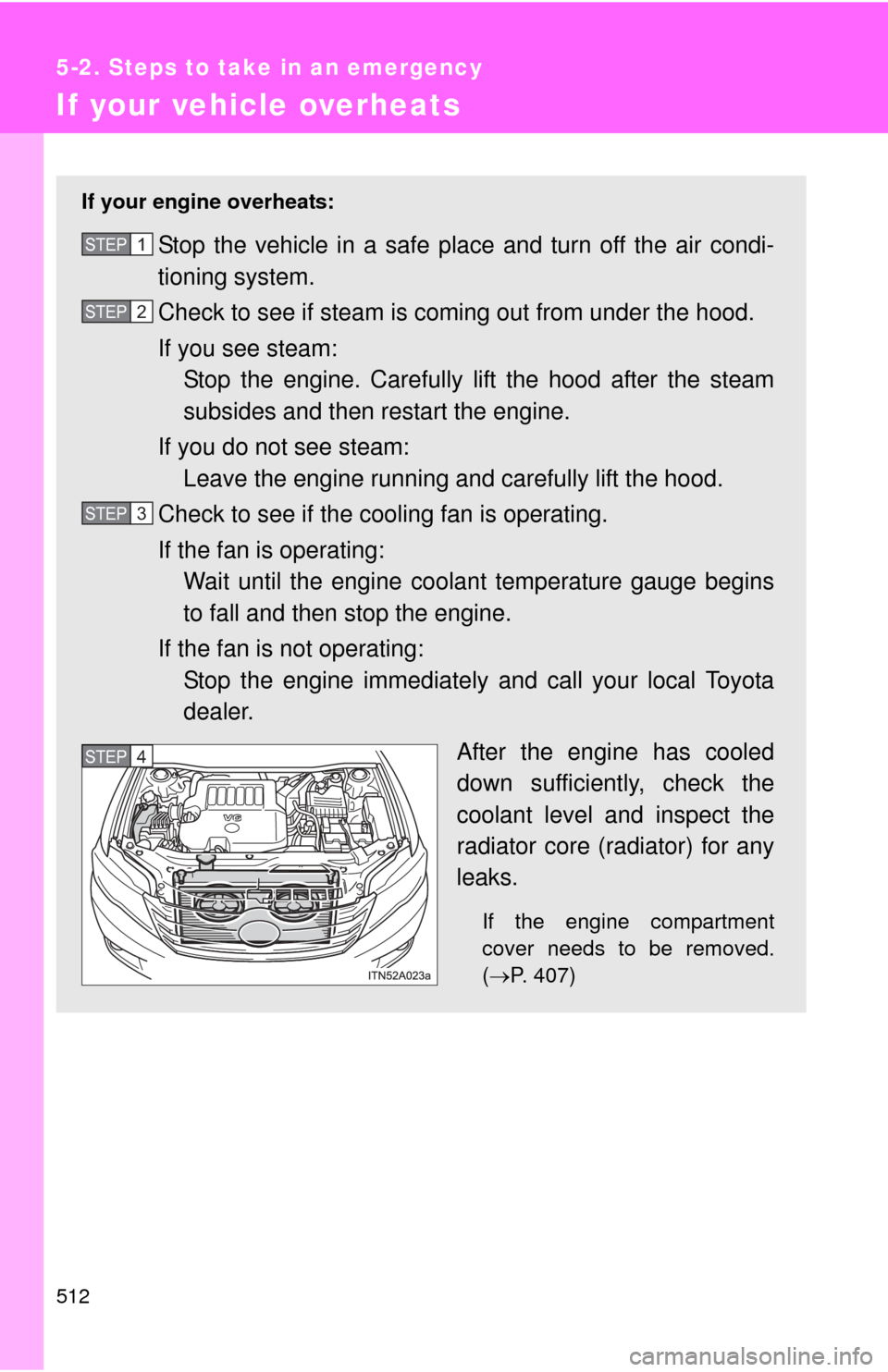
512
5-2. Steps to take in an emergency
If your vehicle overheats
If your engine overheats:
Stop the vehicle in a safe place and turn off the air condi-
tioning system.
Check to see if steam is coming out from under the hood.
If you see steam: Stop the engine. Carefully lift the hood after the steam
subsides and then restart the engine.
If you do not see steam: Leave the engine running and carefully lift the hood.
Check to see if the cooling fan is operating.
If the fan is operating: Wait until the engine coolant temperature gauge begins
to fall and then stop the engine.
If the fan is not operating: Stop the engine immediately and call your local Toyota
dealer.
After the engine has cooled
down sufficiently, check the
coolant level and inspect the
radiator core (radiator) for any
leaks.
If the engine compartment
cover needs to be removed.
(P. 407)
STEP1
STEP2
STEP3
STEP4
Page 524 of 580
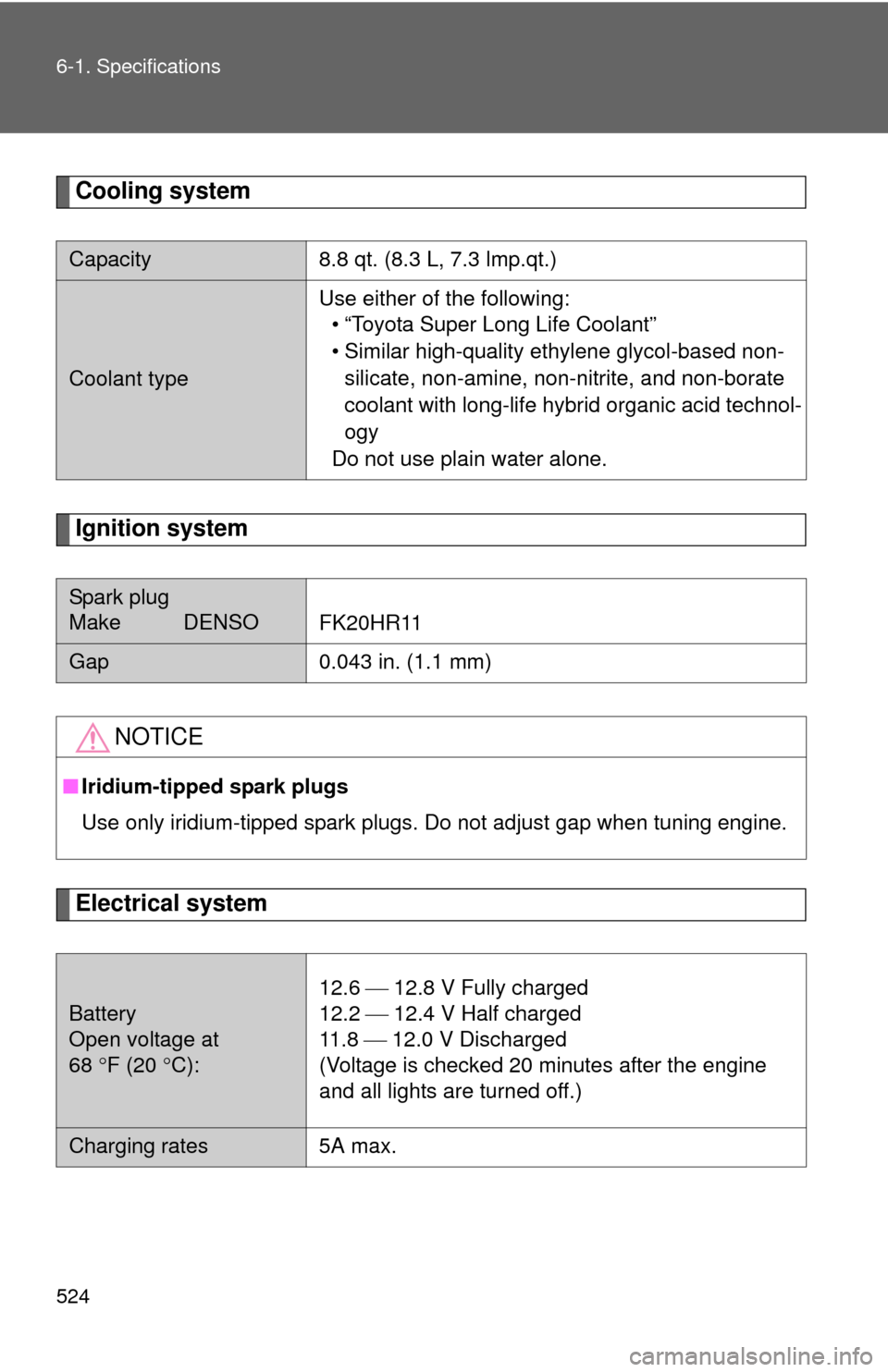
524 6-1. Specifications
Cooling system
Ignition system
Electrical system
Capacity8.8 qt. (8.3 L, 7.3 lmp.qt.)
Coolant typeUse either of the following:
• “Toyota Super Long Life Coolant”
• Similar high-quality ethylene glycol-based non-
silicate, non-amine, non-nitrite, and non-borate
coolant with long-life hybrid organic acid technol-
ogy
Do not use plain water alone.
Spark plug
Make DENSO
FK20HR11
Gap 0.043 in. (1.1 mm)
NOTICE
■Iridium-tipped spark plugs
Use only iridium-tipped spark plugs. Do not adjust gap when tuning engine.
Battery
Open voltage at
68 F (20 C):
12.6 12.8 V Fully charged
12.2 12.4 V Half charged
11 . 8 12.0 V Discharged
(Voltage is checked 20 minutes after the engine
and all lights are turned off.)
Charging rates 5A max.
Page 570 of 580
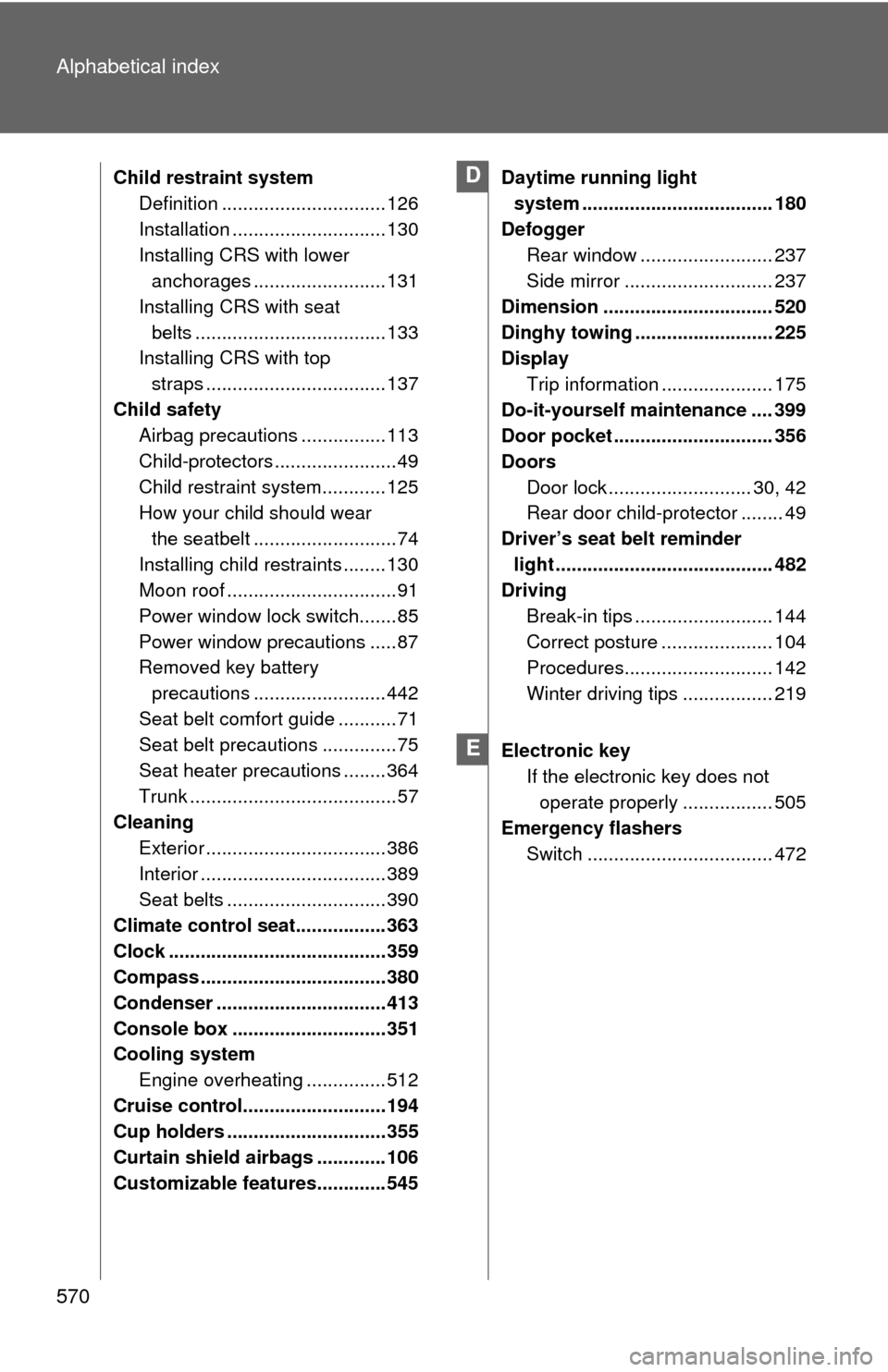
570 Alphabetical index
Child restraint systemDefinition ............................... 126
Installation ............................. 130
Installing CRS with lower anchorages ......................... 131
Installing CRS with seat belts .................................... 133
Installing CRS with top
straps .................................. 137
Child safety Airbag precautions ................113
Child-protectors .......................49
Child restraint system............ 125
How your child should wear
the seatbelt ...........................74
Installing child restraints ........ 130
Moon roof ................................91
Power window lock switch.......85
Power window precautions .....87
Removed key battery precautions ......................... 442
Seat belt comfort guide ........... 71
Seat belt precautions ..............75
Seat heater precautions ........ 364
Trunk .......................................57
Cleaning
Exterior .................................. 386
Interior ................................... 389
Seat belts .............................. 390
Climate control seat................. 363
Clock ......................................... 359
Compass ................................... 380
Condenser ................................ 413
Console box ............................. 351
Cooling system Engine overheating ............... 512
Cruise control........................... 194
Cup holders .............................. 355
Curtain shield airbags ............. 106
Customizable features............. 545 Daytime running light
system .................................... 180
Defogger Rear window ......................... 237
Side mirror ............................ 237
Dimension ................................ 520
Dinghy towing .......................... 225
Display Trip information ..................... 175
Do-it-yourself maintenance .... 399
Door pocket .............................. 356
Doors Door lock ........................... 30, 42
Rear door child-protector ........ 49
Driver’s seat belt reminder light ......................................... 482
Driving
Break-in tips .......................... 144
Correct posture ..................... 104
Procedures............................ 142
Winter driving tips ................. 219
Electronic key If the electronic key does not operate properly ................. 505
Emergency flashers Switch ................................... 472D
E